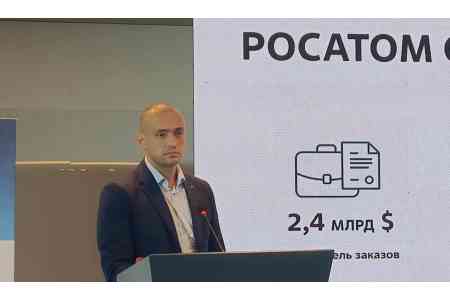


ArmInfo. The second program to extend the service life of power unit No. 2 is ongoing at the Armenian Nuclear Power Plant (ANPP). An ArmInfo correspondent spoke with Yuri Sviridenko, Head of the Integrated Projects Department of Rosatom Service JSC, about its nuances and differences from the first program.
- The second program to extend the service life of power unit No. 2 is ongoing at the ANPP. What is planned to be done within the framework of this program, and how does it differ from the first?
- Several aspects should be kept in mind here. Firstly, if during the first program we were responsible for the entire extension as a whole, then the Armenian Nuclear Power Plant is responsible for most of the work within the second program. Our area of responsibility includes a set of activities that covers one third of the total volume of work on the project. Our Armenian partners have taken on such a significant block of work and are successfully implementing it.
Secondly, all work on the extension project is described in the "Program for the repeated extension of the service life of power unit No. 2 of the Armenian NPP". This document was approved last year by the government of Armenia, and on its basis the main base is being built, within the framework of which the current work is being carried out.
Our scope of work includes a set of measures in various areas, the key one of which is the development and presentation of a justification for the possibility of operating the reactor facility until 2036. However, we will make the calculation with an eye to 2041. This does not mean that the task is to extend the service life of the second power unit not until 2036, but until 2041. For such a long-term perspective, calculations are made and the situation is analyzed. Based on the results of all studies, the specific possible service life of the plant will become clear.
We are also responsible for further modernization of safety systems. We will move to the implementation of a new range of design basis accidents - these are probable accidents that must be provided for in safety systems. The purpose of such measures is to exclude any possibility of adverse consequences.
In particular, if a pipe with a diameter of 200 mm ruptures, the safety system must be triggered, which will avoid any risks. We are focused on increasing safety and further bringing the station unit closer to international safety standards.
We have also taken on the tasks of increasing fire safety at the nuclear power plant, modernizing the systems of auxiliary main circulation pumps - those that ensure the removal of heat from the fuel, converting it into steam and transferring it to the turbogenerator. There are also a number of other, smaller tasks.
We have also begun to conduct material science research, since the plant will be operated for quite a long time beyond its service life, and for this reason, work is being carried out to control the metal of the reactor vessel. For this purpose, special samples of the reactor vessel metal have been developed and manufactured, using which, starting this year, studies will be conducted annually for changes in the properties of the metal. At the same time, the vessel will not be involved - a sample of similar metal will be placed directly next to it, which will be tested in the laboratory for deterioration in the properties of the metal. The test will determine whether it is possible to continue operating the entire unit. Such a program already exists and will be in effect until 2028. After this period, a new program will be required for the remaining period of operation.
- You mentioned that Rosatom Service will carry out about 23 events at the plant. And how many similar events will the Armenian side carry out?
It is difficult for me to answer this question now, but I can imagine the situation in monetary terms. The Armenian government has allocated $165 million for the entire program of repeated extension, and framework contracts for $57.5 million have been concluded in our area of responsibility. The remaining volume is being implemented by the ANPP independently.
- There is some wariness among the population of Armenia regarding the construction of a powerful nuclear unit. There is an opinion about the need to build small nuclear modular power plants, since they allegedly do not pose a danger to the population. What do you think about this?
From the point of view of the existing rules, I should note that both small and large nuclear units have the same safety elements, since both are about handling fresh and spent nuclear fuel, radioactive waste, which require special storage, transportation and processing, excluding the impact on the environment.
The whole question is in the maturity of the technologies used. According to the current situation, the State Corporation has references for small modular reactors, as evidenced by the floating NPP in Pevek, the small NPP under construction in Yakutia and the first export contract of Rosatom in the world for the construction of a small NPP in Uzbekistan. These are practically all the NPPs with SMRs that exist in the world. And this is not counting the Russian icebreakers using this type of reactor.
In other words, Russia has accumulated a huge, unique experience in the world of working with MMRs - other examples outside the country, with the exception of China, are either at the level of design projects or at the stage of obtaining design licenses.
- Thank you.